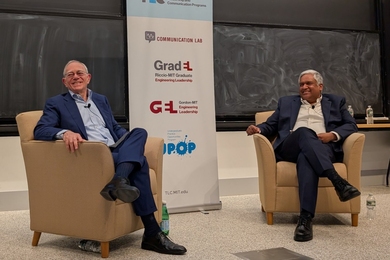Well into the 20th century, American weather forecasting was not a rigorous science, but an “art,” as a National Research Council report stated in 1918. Forecasters knew, among other things, that weather generally moved from the west; that high barometric pressure indicated cold temperatures; and that low pressure meant rain. They would collect data by telegraph, make charts and provide forecasts, which were often faulty. Weathermen were popular objects of ridicule.
By the early 1940s, however, American universities were training thousands of military weather forecasters to see the atmosphere as a dynamic global system driven by powerful high-altitude winds. During World War II, this approach helped determine the timing of crucial Allied operations such as the D-Day invasion.
In large part, this transformation of American meteorology stemmed from one gregarious, fun-loving Swedish scientist: Carl-Gustaf Rossby, who founded the country’s first meteorology program at MIT in 1928, gave the discipline mathematical rigor and designed the curriculum for those World War II forecasters. Rossby literally added a new dimension — the vertical one — to forecasting, by identifying and mathematically describing the powerful high-altitude winds that influence weather, which let scientists model the whole atmosphere.
“He was the foremost meteorologist of his generation,” says Kerry Emanuel, the Breene M. Kerr (1951) Professor of Atmospheric Science at MIT. “Rossby wanted to bring weather forecasting from the 19th century into the 20th century.”
Achieving that aim once made Rossby famous: Time magazine ran a cover story on the “high-spirited” Swede in the 1950s, when meteorologists, including a stellar group at MIT, were ushering forecasting into the computer age. His influence remains with us: Those red and blue lines denoting warm and cold fronts on weather maps were Rossby’s idea. He also mapped and named the “jet stream.” Yet few people today know the tale of Rossby and MIT meteorology.
The wind beneath their wings
Rossby began studying meteorology at Norway’s Geophysical Institute in 1919. That same year, a new approach to forecasting — later dubbed the “Bergen School” — came from one of the institute’s scientists, Vilhelm Bjerknes, who proposed that weather systems were produced by collisions between masses of cold and warm air, with the cold air undercutting the warm air. He called these collision areas “fronts.”
In 1925, Rossby joined the U.S. Weather Bureau, hoping to bring the new ideas to America. But he was largely ignored, except when he angered his stodgy superiors by providing a freelance forecast for famed aviator Charles Lindbergh’s flight to Mexico.
Rossby soon landed at MIT, founded the meteorology program and began collecting upper-atmosphere data. In 1931, MIT meteorologists bought a Cessna monoplane and put weather instruments on board. Professor Daniel Sayre performed six months of daily flights from East Boston (now Logan) Airport, often in poor conditions, although the scientists played down the risks.
“The number of forced landings was very small and only one major repair was required,” Rossby noted dryly in a summary he wrote for the 1932 MIT President’s Report.
A better method involved equipping weather balloons with radiosondes, probes that sent back high-altitude data. Rossby’s great breakthrough, in 1939, came from this data: He found that the upper atmosphere contained long, slow-moving waves of air, extending for hundreds of miles, that twist over mountain ranges and amplify when they collide. We now call them Rossby waves.
“It was a discovery of the basic dynamical building block of the weather,” Emanuel says. The waves showed how much a three-dimensional knowledge of the atmosphere was necessary for weather forecasting, as Bjerknes had suspected. Rossby’s equations describing the waves helped forecasting become a kind of applied physics, as a branch of fluid dynamics.
“Rossby did a lot to establish that philosophy of weather analysis in the United States,” says Norman Phillips, an eminent retired meteorologist from MIT.
Rossby accomplished this with panache, holding court in Cambridge’s finer restaurants; Time said Rossby was “so full of bounce he could hardly stay on the floor.” Yet he was also eyeing a return home. “I’m quite convinced my dad meant to move back to Sweden with my mother in the 1930s, but he was having so much fun in this country, and his skills were so appreciated, he couldn’t break loose,” says his son Thomas Rossby PhD ’66, an oceanographer at the University of Rhode Island. “Then the threat of World War II got bigger and bigger, so they stayed.”
Weathering the war
Indeed, World War II dramatically increased the need for forecasting. The U.S. military set up university training programs in meteorology, starting at MIT, and Rossby designed the curriculum, while becoming a consultant to U.S. Secretary of War Henry Stimson.
“He knew how to work his way through the world and get things done,” Thomas Rossby says.
By 1944, thousands of military officers had completed graduate-level training in meteorology, 994 of them at MIT. Uniquely, MIT’s program included 25 women. A black lieutenant, Wallace P. Reed, also completed MIT’s program in 1942 and then commanded the military’s all-black weather unit at the Tuskegee Institute in Alabama.
Rossby formally left MIT in 1939. Sverre Pettersen, a Norwegian meteorologist and another adherent of the Bergen School approach, replaced Rossby as program head at MIT, then joined the war effort in 1942. Pettersen became one of a half-dozen core D-Day forecasters, as the upper-air specialist planning the Allied invasion of Normandy. By most accounts, this was a fraught process, especially when terrible weather postponed the planned June 5, 1944, landing date; storms were overhead, and another seemed to be blowing in from the Atlantic.
In his memoir, Pettersen writes that on June 5, conditions in the upper atmosphere changed: “[T]he strong and almost straight current [at high altitudes over the Atlantic] that had dominated the scene the whole week had suddenly changed into a wave-shaped pattern.” That meant, he told his superiors on June 5, that the storm drifting in from the Atlantic “cannot continue to move eastward as fast as I have predicted earlier,” giving the Allies a weather window for a June 6 landing.
Later, some accounts cast Pettersen as opposing a June 6 landing, something he rebuts in his book, saying it was precisely his familiarity with high-altitude winds that let him recognize the opportunity. Certainly, military leaders acknowledged his work. General Dwight Eisenhower, the Allied supreme commander, wrote to Pettersen, praising him for his “reconciliation of differences in forecasting methods,” adding that Pettersen’s work deserved “very special commendation as an outstanding contribution to the success of the Allied invasion.”
Computers and Olympians
By the 1950s, Rossby did return to work in Sweden, soon after mapping the fast-moving, high-altitude winds he called the “jet stream,” named for the World War II planes that encountered them. But the approach Rossby championed had taken hold in the United States, and MIT’s program enjoyed a new golden age. By the mid-1950s, it boasted the path-breaking meteorologist Jule Charney, who had constructed the first computerized forecast with mathematician John von Neumann in 1950. Other prominent MIT faculty meteorologists included Phillips, Victor Starr and Edward Lorenz.
Phillips’ own modeling of the atmosphere — dividing it into two layers — proved highly influential, while Starr and Lorenz both performed important work on the atmosphere’s general circulation. And they all created an intellectual atmosphere in which ideas circulated freely.
“There was a very active group that established the spirit that guided the department,” recalls Phillips, now 89 and living in Merrimack, N.H. “It was unusual to have a closed office door. That applied to both students and faculty.”
Students of the period remember it fondly, too. “The meteorology department in those days was like a dream,” says Joseph Pedlosky ’60, SM ’60, PhD ’63, a research scientist emeritus in physical oceanography at the Woods Hole Oceanographic Institution in Massachusetts. “Jule Charney, Norman Phillips, Victor Starr, Ed Lorenz — they were all Olympians.”
Lorenz — a graduate of MIT’s military training program of the 1940s — added a new insight to forecasting in 1961, when he discovered that rounding a few digits off one decimal number in a computer simulation of weather changed its entire long-term pattern. This “sensitive dependence on initial conditions” is the founding insight of chaos theory, and implies something deep about nature and forecasting: Little changes in nature can produce large effects, which is one reason weather lacks the highly repeating patterns forecasters long sought. Instead, slightly imprecise measurements or overlooked details can produce inaccurate long-term forecasts.
Rossby did not see this latter development. In 1957, he died of a heart attack at age 58. “Everybody was hoping for another 10 or 20 years out of Rossby,” says James Fleming, a historian of science at Colby College in Maine. “It came as a great shock.” But his legacy lives on in our forecasts — and those red and blue front lines.
By the early 1940s, however, American universities were training thousands of military weather forecasters to see the atmosphere as a dynamic global system driven by powerful high-altitude winds. During World War II, this approach helped determine the timing of crucial Allied operations such as the D-Day invasion.
In large part, this transformation of American meteorology stemmed from one gregarious, fun-loving Swedish scientist: Carl-Gustaf Rossby, who founded the country’s first meteorology program at MIT in 1928, gave the discipline mathematical rigor and designed the curriculum for those World War II forecasters. Rossby literally added a new dimension — the vertical one — to forecasting, by identifying and mathematically describing the powerful high-altitude winds that influence weather, which let scientists model the whole atmosphere.
“He was the foremost meteorologist of his generation,” says Kerry Emanuel, the Breene M. Kerr (1951) Professor of Atmospheric Science at MIT. “Rossby wanted to bring weather forecasting from the 19th century into the 20th century.”
Achieving that aim once made Rossby famous: Time magazine ran a cover story on the “high-spirited” Swede in the 1950s, when meteorologists, including a stellar group at MIT, were ushering forecasting into the computer age. His influence remains with us: Those red and blue lines denoting warm and cold fronts on weather maps were Rossby’s idea. He also mapped and named the “jet stream.” Yet few people today know the tale of Rossby and MIT meteorology.
The wind beneath their wings
Rossby began studying meteorology at Norway’s Geophysical Institute in 1919. That same year, a new approach to forecasting — later dubbed the “Bergen School” — came from one of the institute’s scientists, Vilhelm Bjerknes, who proposed that weather systems were produced by collisions between masses of cold and warm air, with the cold air undercutting the warm air. He called these collision areas “fronts.”
In 1925, Rossby joined the U.S. Weather Bureau, hoping to bring the new ideas to America. But he was largely ignored, except when he angered his stodgy superiors by providing a freelance forecast for famed aviator Charles Lindbergh’s flight to Mexico.
Rossby soon landed at MIT, founded the meteorology program and began collecting upper-atmosphere data. In 1931, MIT meteorologists bought a Cessna monoplane and put weather instruments on board. Professor Daniel Sayre performed six months of daily flights from East Boston (now Logan) Airport, often in poor conditions, although the scientists played down the risks.
“The number of forced landings was very small and only one major repair was required,” Rossby noted dryly in a summary he wrote for the 1932 MIT President’s Report.
A better method involved equipping weather balloons with radiosondes, probes that sent back high-altitude data. Rossby’s great breakthrough, in 1939, came from this data: He found that the upper atmosphere contained long, slow-moving waves of air, extending for hundreds of miles, that twist over mountain ranges and amplify when they collide. We now call them Rossby waves.
“It was a discovery of the basic dynamical building block of the weather,” Emanuel says. The waves showed how much a three-dimensional knowledge of the atmosphere was necessary for weather forecasting, as Bjerknes had suspected. Rossby’s equations describing the waves helped forecasting become a kind of applied physics, as a branch of fluid dynamics.
“Rossby did a lot to establish that philosophy of weather analysis in the United States,” says Norman Phillips, an eminent retired meteorologist from MIT.
Rossby accomplished this with panache, holding court in Cambridge’s finer restaurants; Time said Rossby was “so full of bounce he could hardly stay on the floor.” Yet he was also eyeing a return home. “I’m quite convinced my dad meant to move back to Sweden with my mother in the 1930s, but he was having so much fun in this country, and his skills were so appreciated, he couldn’t break loose,” says his son Thomas Rossby PhD ’66, an oceanographer at the University of Rhode Island. “Then the threat of World War II got bigger and bigger, so they stayed.”
Weathering the war
Indeed, World War II dramatically increased the need for forecasting. The U.S. military set up university training programs in meteorology, starting at MIT, and Rossby designed the curriculum, while becoming a consultant to U.S. Secretary of War Henry Stimson.
“He knew how to work his way through the world and get things done,” Thomas Rossby says.
By 1944, thousands of military officers had completed graduate-level training in meteorology, 994 of them at MIT. Uniquely, MIT’s program included 25 women. A black lieutenant, Wallace P. Reed, also completed MIT’s program in 1942 and then commanded the military’s all-black weather unit at the Tuskegee Institute in Alabama.
Rossby formally left MIT in 1939. Sverre Pettersen, a Norwegian meteorologist and another adherent of the Bergen School approach, replaced Rossby as program head at MIT, then joined the war effort in 1942. Pettersen became one of a half-dozen core D-Day forecasters, as the upper-air specialist planning the Allied invasion of Normandy. By most accounts, this was a fraught process, especially when terrible weather postponed the planned June 5, 1944, landing date; storms were overhead, and another seemed to be blowing in from the Atlantic.
In his memoir, Pettersen writes that on June 5, conditions in the upper atmosphere changed: “[T]he strong and almost straight current [at high altitudes over the Atlantic] that had dominated the scene the whole week had suddenly changed into a wave-shaped pattern.” That meant, he told his superiors on June 5, that the storm drifting in from the Atlantic “cannot continue to move eastward as fast as I have predicted earlier,” giving the Allies a weather window for a June 6 landing.
Later, some accounts cast Pettersen as opposing a June 6 landing, something he rebuts in his book, saying it was precisely his familiarity with high-altitude winds that let him recognize the opportunity. Certainly, military leaders acknowledged his work. General Dwight Eisenhower, the Allied supreme commander, wrote to Pettersen, praising him for his “reconciliation of differences in forecasting methods,” adding that Pettersen’s work deserved “very special commendation as an outstanding contribution to the success of the Allied invasion.”
Computers and Olympians
By the 1950s, Rossby did return to work in Sweden, soon after mapping the fast-moving, high-altitude winds he called the “jet stream,” named for the World War II planes that encountered them. But the approach Rossby championed had taken hold in the United States, and MIT’s program enjoyed a new golden age. By the mid-1950s, it boasted the path-breaking meteorologist Jule Charney, who had constructed the first computerized forecast with mathematician John von Neumann in 1950. Other prominent MIT faculty meteorologists included Phillips, Victor Starr and Edward Lorenz.
Phillips’ own modeling of the atmosphere — dividing it into two layers — proved highly influential, while Starr and Lorenz both performed important work on the atmosphere’s general circulation. And they all created an intellectual atmosphere in which ideas circulated freely.
“There was a very active group that established the spirit that guided the department,” recalls Phillips, now 89 and living in Merrimack, N.H. “It was unusual to have a closed office door. That applied to both students and faculty.”
Students of the period remember it fondly, too. “The meteorology department in those days was like a dream,” says Joseph Pedlosky ’60, SM ’60, PhD ’63, a research scientist emeritus in physical oceanography at the Woods Hole Oceanographic Institution in Massachusetts. “Jule Charney, Norman Phillips, Victor Starr, Ed Lorenz — they were all Olympians.”
Lorenz — a graduate of MIT’s military training program of the 1940s — added a new insight to forecasting in 1961, when he discovered that rounding a few digits off one decimal number in a computer simulation of weather changed its entire long-term pattern. This “sensitive dependence on initial conditions” is the founding insight of chaos theory, and implies something deep about nature and forecasting: Little changes in nature can produce large effects, which is one reason weather lacks the highly repeating patterns forecasters long sought. Instead, slightly imprecise measurements or overlooked details can produce inaccurate long-term forecasts.
Rossby did not see this latter development. In 1957, he died of a heart attack at age 58. “Everybody was hoping for another 10 or 20 years out of Rossby,” says James Fleming, a historian of science at Colby College in Maine. “It came as a great shock.” But his legacy lives on in our forecasts — and those red and blue front lines.







